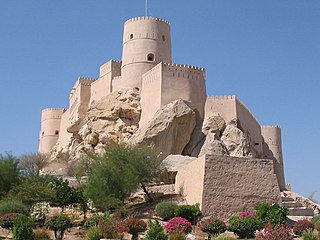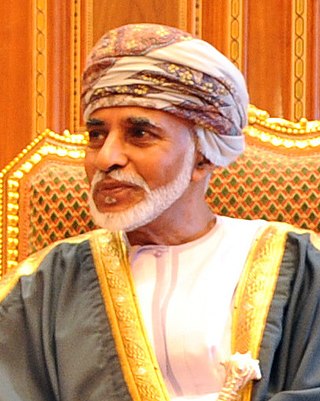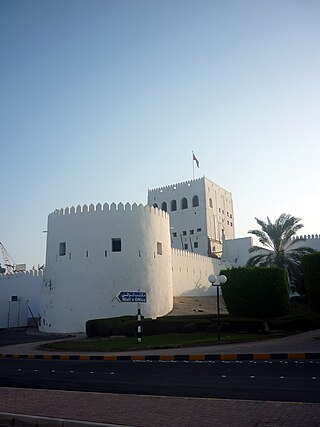
Oman, officially the Sultanate of Oman, is a country on the southeastern coast of the Arabian Peninsula in West Asia. It shares land borders with Saudi Arabia, the United Arab Emirates, and Yemen. The capital and largest city is Muscat. Oman has a population of about 5.28 million as of 2024, which is a 4.60% population increase from 2023. and is the 123rd most-populous country. The coast faces the Arabian Sea on the southeast, and the Gulf of Oman on the northeast. The Madha and Musandam exclaves are surrounded by United Arab Emirates on their land borders, with the Strait of Hormuz and the Gulf of Oman forming Musandam's coastal boundaries.

Oman is a site of pre-historic human habitation, stretching back over 100,000 years. The region was impacted by powerful invaders, including other Arab tribes, Portugal and Britain. Oman, at its height, held holdings that ranged from the Persian Gulf all the way south to the island of Madagascar, some notable holdings include; the island of Zanzibar and the city of Gwadar.

Oman is a country on the southeast coast of the Arabian Peninsula, situated in West Asia, bordering the Arabian Sea, Gulf of Oman, and Persian Gulf, between Yemen and the United Arab Emirates (UAE). The coast of Oman was an important part in the Omani empire and sultanate.
This article is about transport in Oman.

Muscat is the capital and most populous city in Oman. It is the seat of the Governorate of Muscat. According to the National Centre for Statistics and Information (NCSI), the population of the Muscat Governorate in 2022 was 1.72 million. The metropolitan area includes six provinces, called wilayats, and spans approximately 3,500 km2 (1,400 sq mi), making it the largest city by area on the Arabian Peninsula. Known since the early 1st century AD as a leading port for trade between the west and the east, Muscat was ruled successively by various indigenous tribes, as well as by foreign powers such as the Persians, the Portuguese Empire and the Ottoman Empire. In the 18th century, Muscat was a regional military power: its influence extended as far as East Africa and Zanzibar. As an important port town in the Gulf of Oman, Muscat attracted foreign traders and settlers such as the Persians, the Balochs and the Sindhis. Beginning in 1970, after the accession of Qaboos bin Said as the Sultan of Oman, Muscat experienced rapid infrastructural development; it developed a vibrant economy and became a multi-ethnic society. The Globalization and World Cities Research Network classifies Muscat as a Beta-level Global City.

Al Ain is a city in the Emirate of Abu Dhabi, United Arab Emirates and the seat of the administrative division of the Al Ain Region. The city is bordered to the east by the Omani town of Al-Buraimi. Al Ain is the largest inland city in the Emirates, the fourth-largest city, and the second-largest in the Emirate of Abu Dhabi. The freeways connecting Al Ain, Abu Dhabi, and Dubai form a geographic triangle in the country, each city being roughly 130 kilometres (81 mi) from the others.

Qaboos bin Said Al Said was Sultan of Oman from 23 July 1970 until his death in 2020. A fifteenth-generation descendant of the founder of the House of Al Said, he was the longest-serving leader in the Middle East and Arab world at the time of his death, having ruled for almost half a century.
The Omani territory of Madha is an exclave of the Musandam Governorate, enclaved by the United Arab Emirates (UAE); inside it, there is a second-order enclave: Nahwa, which is part of the UAE Emirate of Sharjah. Madha is located halfway between the Musandam Peninsula and the rest of Oman.
The Oman national football team represents Oman in men's international football and is controlled by the Oman Football Association.

Salalah is the capital and largest city of the southern Omani governorate of Dhofar. It has a population close to 331,949.

Nizwa is the largest city in Ad Dakhiliyah Region in Oman and was the capital of Oman proper. Nizwa is about 140 km from the Omani capital Muscat. The population is estimated at around 83,544 people.

Sohar is the capital and largest city of the Al Batinah North Governorate in Oman. An ancient capital of the country that once served as an important Islamic port town on the Gulf of Oman, Sohar has also been credited as the mythical birthplace of Sinbad the Sailor. It was historically known as Mazūn (مَزُوْن).

Al-Seeb, As Seeb, As Sib, or Seeb is a coastal fishing province, located several kilometres northwest of Muscat, in northeastern Oman. At the 2020 census, it had a population of 470,878.

Barka is a coastal city and Wilayah (Province) in the region Al Bāţinah, in northern Oman. Bordered by the Sea of Oman and the Hajar Mountains in southern Batinah, Barka is about a half-hour drive from As-Seeb and roughly an hour's drive from Al-Khuwair and Ruwi.

Sur is the capital city of Ash Sharqiyah South Governorate, and the former capital of Ash Sharqiyah Region in northeastern Oman, on the coast of the Gulf of Oman. It is located about 203 km southeast of the Omani capital Muscat. Historically, the city has been an important port connecting the Gulf and the Indian subcontinent via the Arabian Sea since as early as 16th century.

The Oman Professional League, previously known as the Omantel Elite League, is the top division of the Oman Football Association, and was officially created in 1976. Currently, the most successful team in the league is Dhofar with 12 titles to their name.

Omani Arabic is a variety of Arabic spoken in the Al Hajar Mountains of Oman and in a few neighboring coastal regions. It is the easternmost traditional Arabic dialect. It was formerly spoken by colonists in Kenya and Tanzania, but these days, it mainly remains spoken on the island of Zanzibar.

The House of Al Bu Said, is the current ruling royal family of Oman, and former ruling house of the Omani Empire (1744–1856), Sultanate of Muscat and Oman (1856–1970) and the Sultanate of Zanzibar (1856–1964). It was founded by Ahmad bin Said Al Busaidi in 1744 and is currently headed by Haitham bin Tariq Al Said.

The Omani Empire was a maritime empire, vying with Portugal and Britain for trade and influence in the Persian Gulf and Indian Ocean. After rising as a regional player in the 18th century, the empire at its peak in the 19th century saw its influence or control extend across the Strait of Hormuz to modern-day Iran and Pakistan, and as far south as Cape Delgado. After the death of Said bin Sultan in 1856 the empire was divided between his sons into two sultanates, an African section ruled by Majid bin Said and an Asian section ruled by Thuwaini bin Said.

Haitham bin Tariq Al Said is Sultan and Prime Minister of Oman.




















